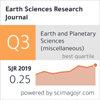随机森林方法在测井资料油水层识别中的应用——以辽河坳陷为例
IF 0.5
4区 地球科学
Q4 GEOSCIENCES, MULTIDISCIPLINARY
引用次数: 0
摘要
油水层的准确识别是对储层流体性质或工业价值进行定性评价和选择油井测试层的基础。传统的油水层识别主要是基于对测井和测井数据的广泛使用,对于地质条件复杂的储层,这种方法效率低,容易解释或曲解。本文采用机器学习的随机森林方法,选取岩石的岩性、孔隙度、渗透率、可动流体、含油饱和度、S0、S1、S2、Tmax为特征;采用冲击过采样法对样本进行扩展,采用分组估计法建立油水层识别模型。这种方法简单易用,不容易出现严重的过拟合,并且可以在数据中找到潜在的规则。分类性能优异,准确率可达89.9%以上,解决了以往油水层识别精度低的问题。本文章由计算机程序翻译,如有差异,请以英文原文为准。
Application of Random Forest method in oil and water layer identification of logging data: a case study of the Liaohe depression
Accurate identification of oil and water layers is the basis of qualitative evaluation of reservoir fluid properties or industrial value and selection of testing layers of the well. The traditional oil and water layer identification is mainly based on the extensive use of the well’s logging and logging data, which is inefficient and easy to leak interpretation or misinterpretation for those reservoirs with complex geological conditions. In this paper, the random forest method of machine learning is used to select the lithology, porosity, permeability, movable fluid, oil saturation, S0, S1, S2, Tmax of rock as characteristics; smote oversampling is used to expand the sample, and the packet estimation is used to establish the oil and water layer identification model. This method is simple and easy to use, not prone to severe overfitting, and can find the potential rules in the data. The classification performance is excellent, and the accuracy rate can reach more than 89.9%, which solves the problem of low accuracy in oil-water layer identification in the past.
求助全文
通过发布文献求助,成功后即可免费获取论文全文。
去求助
来源期刊

Earth Sciences Research Journal
地学-地球科学综合
CiteScore
1.50
自引率
0.00%
发文量
0
审稿时长
>12 weeks
期刊介绍:
ESRJ publishes the results from technical and scientific research on various disciplines of Earth Sciences and its interactions with several engineering applications.
Works will only be considered if not previously published anywhere else. Manuscripts must contain information derived from scientific research projects or technical developments. The ideas expressed by publishing in ESRJ are the sole responsibility of the authors.
We gladly consider manuscripts in the following subject areas:
-Geophysics: Seismology, Seismic Prospecting, Gravimetric, Magnetic and Electrical methods.
-Geology: Volcanology, Tectonics, Neotectonics, Geomorphology, Geochemistry, Geothermal Energy, ---Glaciology, Ore Geology, Environmental Geology, Geological Hazards.
-Geodesy: Geodynamics, GPS measurements applied to geological and geophysical problems.
-Basic Sciences and Computer Science applied to Geology and Geophysics.
-Meteorology and Atmospheric Sciences.
-Oceanography.
-Planetary Sciences.
-Engineering: Earthquake Engineering and Seismology Engineering, Geological Engineering, Geotechnics.
 求助内容:
求助内容: 应助结果提醒方式:
应助结果提醒方式:


